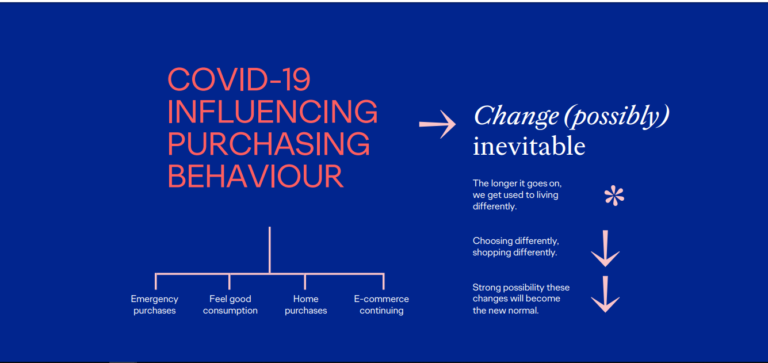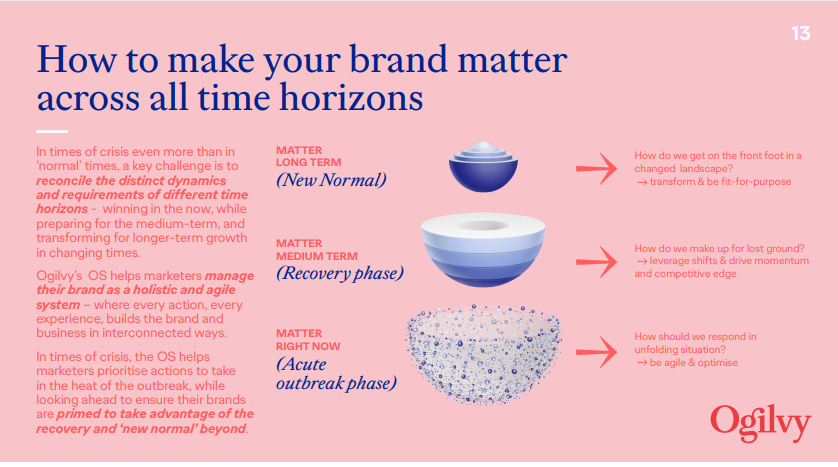by Neo Makhele
https://retailingafrica.com/branding/brand-planning-for-a-post-covid-world/
This is what every South African brand should be doing right now to ensure they emerge from the COVID-19 crisis stronger than ever. The coronavirus outbreak is causing the most disruptive behaviour shifts anyone in the industry has ever experienced (assuming that no one working now was planning during World War 2). Brand consumption patterns in South Africa and across the globe have been radically disrupted.
The key questions for marketers right now are: how much of this behaviour change will become permanent; and how brands can influence consumer choice in this new context. In short, how can they future proof their brand when the future is so uncertain?

One thing is for certain, this kind of disruptive event triggers a trial of new brands. UK research showed 8% of ‘normal consumers’ had recently switched brands; this number went up to 21% of consumers who had recently experienced a major life event such as a wedding, a birth or a death in the family. So, it’s safe to assume that what we are going through right now will create some significant shifts in almost every category. Most of the research and data we have so far about the impact of this crisis on consumers is global, but it is possible to extrapolate this into the SA market space. And everyone agrees that there will not be a return to where we were. This is not a case of ‘back to normal’.

Where we are – the acute outbreak phase
Lockdown is still in place. Brands, by now, should be well on top of their Acute Phase actions.
Where we (hopefully) soon will be – the recovery phase
The economy has re-opened; but there are constraints. Social distancing measures have remained in place, and retail outlets have had to comply with new regulations. Consumers are in a tentative mindset thinking about their financial future; and fears of the virus remain strong. Brands need to communicate safety in their customer journey.
Where brands should now be planning to be – post-Covid.
Actions taken in the first two phases should all have been (or be) informed by the long-term brand horizon – what Ogilvy calls the Brand Platform. Smart brands have used the time afforded to them by the lockdown – with its escape from the weekly grind of marketing calendars – to prepare themselves for this new phase. And it’s worth noting that, in Nike’s experience in China, product sales rebounded remarkably quickly, to the point where they are currently forecasting flat sales in that market for the year rather than any decline. Nike had a considered Return to Market strategy carefully mapped out.
What will the brand future look like?
Frankly, it is hard to say with any conviction what the post-Covid world will look like until we know how long people and the economy remain shackled; and how long there is a pervasive fear of the coronavirus. How quickly COVID-19 passes from front-of-mind consciousness will impact consumer behaviour significantly. But some assumptions can be made:
Money will be very tight, and confidence will be low. It will take a long time for consumers to indulge. Essentials will take priority and luxury will equate to guilt for many. But this will pass. It is a human truth that in booms we can never see the bust; and in the busts, we can never see the booms. Consumers will eventually move on in terms of emotional memory, but their altered behaviour might remain in place.
Online transactions in all possible categories have sky-rocketed and it is likely this behaviour will remain entrenched and that will lead to further exponential growth in online transactions. This is off a low base here in SA (less than 2% of retail was online in SA in 2019); and still restricted to those consumers with decent access to data and a home or office where reliable deliveries can be made.
During lockdown there has been a shift to shopping locally which has re-created a sense of community and identity with the shopkeeper/staff. This may become entrenched at the cost of travelling to the more anonymous environment of a mall. Contactless payments have thrived. Expect more Tap and Go, Zapper, Snapscan and less cash – anything that reduces physical contact in transactions.
Personal finance will become an absolute priority, especially for families – securing the future in an insecure world. Financial services brands of all kinds will see a boom if they deliver the right products and market them well. The complete absence of live sport will have contradictory by-products – a massive pent-up demand and (possibly) a reduced appetite and engagement level, as many people realise that sport wasn’t as essential as it seemed; and they will have developed new leisure habits. Gaming and eSports are big winners in behaviour shift.
Live events will take a long time to recover – 44% of Americans say they will attend fewer large public events after the novel coronavirus outbreak ends. Brands which have used live events as the basis of promotional strategy will need a rethink. Cocooning or ‘Fortress Home’, as Rex Briggs of Marketing Evolution calls it, could make a big comeback. People will prioritise social values like safety and security.
Preparing your brand for the new future
Here are 10 key steps for marketers to take:
Fight for your marketing budget. The absolute priority is to stay active, not to go dark. You will not protect or grow your brand by hiding or through some form of osmosis.
Re-assess your brand platform. In the tactical frenzy of the crisis, smart brands are thinking strategically. Is your brand platform still your North Star or does it need changing in this crisis? Safety, trust and reliability need to be more expressly integral to the brand than before.
Express value. Given the radical economic impact of the virus, find ways to express your brand or products in terms of integral value.
Do not fly blind. When faced with unprecedented levels of disruption and uncertainty, leveraging advanced analytics to support decision-making becomes even more important.
Assess any lifestyle shifts and new behaviours. Rigorously determine their likely impact on your product or business model.
Assess your vulnerability to competitor trial. Did stock shortages or cash pressures cause significant migrations away from your brand or towards it? Work to counter the negative and accentuate the positive.
Check your retail competitors. While you were closed for business, other retailers may have expanded into your space/category. Have a strategy to counter this.
Be flexible. Uncertainty is the new certainty. Create several scenarios and keep adjusting them.
Look to innovate. The marketplace has been disrupted. There will be gaps and an appetite for the new in this new world.
Find ways of being brand positive. Consumers will respond well to a brand that is optimistic and looking forward – provided you get the timing and the tone right. We know that expectation of serious longer-term impact increases with age – younger consumers will bounce back faster. If your target demographic is younger, then be bolder in your assumptions about the future.
When the 2008 financial recession hit, some brands died, and others thrived. It was the brands that stayed the course, invested and innovated, that prospered. The brands that invest wisely now will be the brands that rebound and even expand after the crisis. This means that marketing is becoming more important than it ever has. Our craft has experienced an erosion over the past decade, but it will now experience a re-birth. Great planning and great creativity on every level will produce extraordinary business outcomes for those brands brave enough to build anew in this pivotal moment.
*Additional sources: Ogilvy, WPP, WARC, Kantar, Worldwide Worx, Marketing Evolution, Information Resources Inc. Australia, Illuminera Institute, Affectv, Performance Research.

Neo Makhele is Chief Strategy Officer, Ogilvy South Africa. She is passionate about Africa’s potential and about social justice. In her role as Chief Strategy Officer for Ogilvy, her mandate is to fuel the agency’s modern marketing orientation. She is a board member of the Brand Council South Africa; and is currently busy with her MBA at the Berlin School of Arts.